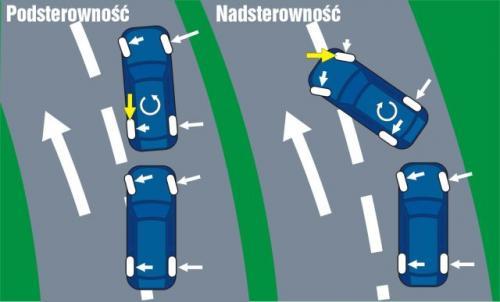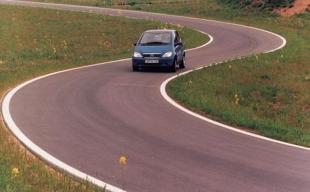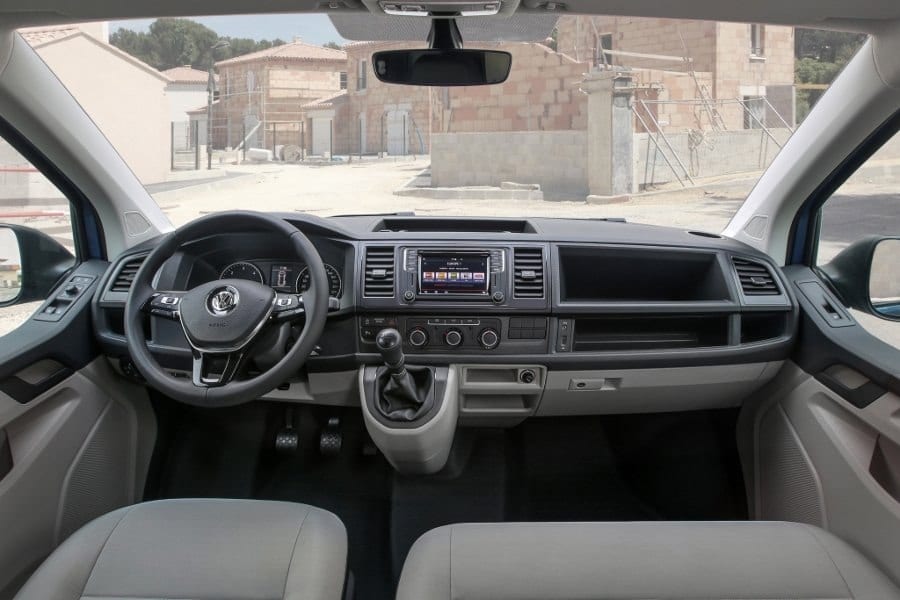
Understeer and oversteer
 Various forces act on a car moving on a road surface. Some of them help the driver while driving, others - vice versa.
Various forces act on a car moving on a road surface. Some of them help the driver while driving, others - vice versa.
Various forces act on a car moving on a road surface. Some of them help the driver while driving, others - vice versa.
The most important forces acting on a moving vehicle are the driving force derived from the torque developed by the engine, braking forces and inertial forces, of which the centrifugal force pushing the vehicle out of a curve if it is moving along a curve plays a central role. important role. The above forces are transmitted by the wheels rolling on the surface. In order for the movement of the car to be stable and no skidding occur, it is important that the resultant of these forces does not exceed the force of adhesion of the wheel to a given surface under certain conditions. Adhesion force  depends, among other things, on the load on the axle of the vehicle, type of tires, tire pressure, as well as on the condition and type of surface.
depends, among other things, on the load on the axle of the vehicle, type of tires, tire pressure, as well as on the condition and type of surface.
The distribution of weight in the car shows that in cars with front-wheel drive, regardless of the number of passengers, the front wheels are well loaded, which helps to achieve high traction. The high driving forces and the dragging effect of the front wheels have a positive effect on the convenience of driving in various conditions, and the drive properties help to intuitively set the track. Rear-wheel drive cars behave completely differently. If only two people are driving in such a vehicle, then the driving rear wheels are lightly loaded, which in adverse conditions reduces the possible driving force, and the phenomenon of pushing the vehicle by the driving wheels makes it necessary to adjust the track more often than in the case of front-wheel drive.
There are two concepts of understeer and oversteer associated with driving a car around curves and corners. The propensity of a car to experience these phenomena is attributed to specific types of movement.
The phenomenon of understeer occurs when, during maneuvers involving high inertial forces, such as cornering at high speed, the front wheels of the vehicle tend to lose traction more quickly and the vehicle pulls away.  outward in an arc despite steering wheel rotation. As if the car is being pushed out of a turn. Vehicle understeer contributes to the self-correction of road noise. Loss of front wheel traction can be compensated for by gentle, pulsating deceleration and depressing the accelerator pedal to increase front axle load and regain agility.
outward in an arc despite steering wheel rotation. As if the car is being pushed out of a turn. Vehicle understeer contributes to the self-correction of road noise. Loss of front wheel traction can be compensated for by gentle, pulsating deceleration and depressing the accelerator pedal to increase front axle load and regain agility.
The opposite of the described phenomenon is oversteer. Occurs when the rear of the vehicle loses traction while cornering at high speed. The car then turns more than the driver wants, and the vehicle itself enters the turn. This behavior of the car when cornering is due to the location of the center of the drive closer to the rear of the car than its center of gravity. In most cases, an oversteer vehicle is rear wheel drive. It enters the curve easily and tends to push the back of the body out of the curve, making it very easy to complete a full vertical turn. This property must be kept in mind when driving on roads with reduced traction, as an oversteered vehicle tends to go outside the curve of the road and fall out of the curve. This phenomenon can be exacerbated by faulty shock absorbers that temporarily lift the rear wheels off the ground. If you lose traction due to excessive wheel steer, decrease the steering angle to bring the rear of the vehicle back on track.
Most cars are designed for slight understeer. If the driver feels insecure and instinctively reduces the pressure on the accelerator pedal, this will cause a tightening of the track on which the front of the car is moving. This is a safe and practical solution.
